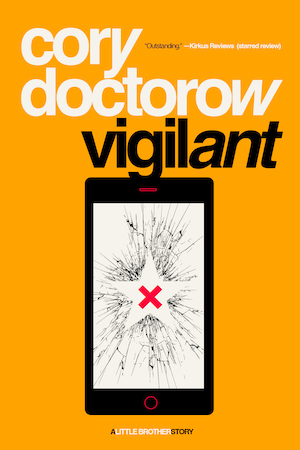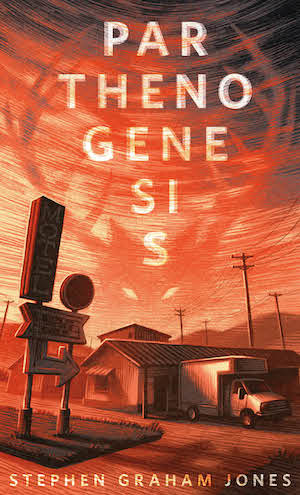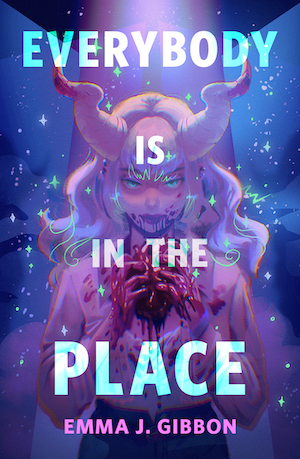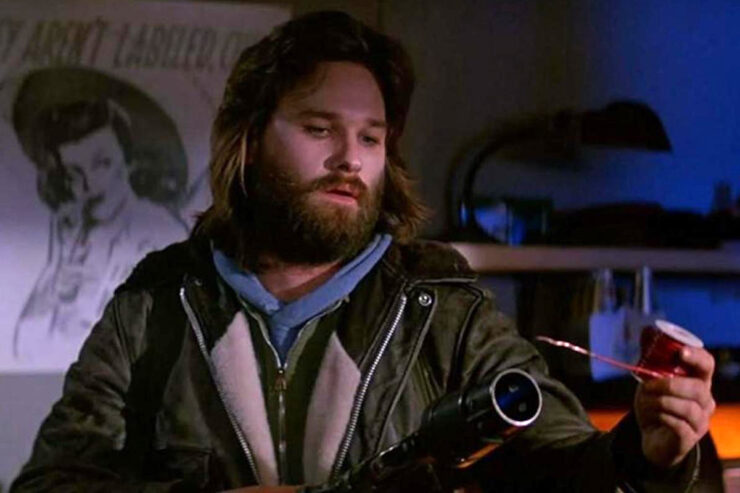The Thing (1982) Directed by John Carpenter. Written by Bill Lancaster. Starring Kurt Russell, Wilford Brimley, T.K. Carter, Keith David, Richard Dysart, Donald Moffat, and Jed the very good wolfdog.
Most people more than passably familiar with sci fi and horror movies know that John Carpenter’s The Thing (1982) was panned by critics when it first came out and has only become a beloved sci fi horror classic in the decades since. Even so, it’s a little surprising to read contemporary reviews and see just how vehemently critics hated this movie.
They despised it. The critical vitriol was free-flowing and nearly universal. The New York Times called it “a foolish, depressing, overproduced movie.” The Washington Post dismissed it as “a wretched excess.” Time said, “The weird lad down the block, the one who is always fooling around with his chemistry set, will love The Thing. The rest of the neighborhood is likely to find it more of a squeamer than a screamer.” A review in the sci fi magazine Starlog wrote, “It has no pace, sloppy continuity, zero humor, bland characters on top of being totally devoid of either warmth or humanity.”
There’s something fascinating about the tenor of these reviews. It’s not just that critics didn’t like the movie. It’s more that a lot of them seem outraged that the movie isn’t what they expected when they went into the theater. They expected blood and gore, but not that much blood and gore. They expected special effects, but not gory, gooey, and grotesque special effects. They expected horror—but not, apparently, horror that would make them feel bad.
Audiences didn’t embrace the movie at first either. The Thing did poorly at the box office; it earned back its $15 million budget, barely, but not much more than that. It was such a failure that it risked destroying John Carpenter’s career. Universal bought out his contract rather than following through on their agreement to have him direct Firestarter (1984) and other films. He has spoken several times over the years about how his career would have looked very different if The Thing had been a success.
A lot of moves get a chance at critical reassessment over time; our cultural and social relationship to art is not static, nor should it be. But it’s rare for a consensus to swing so completely from one extreme (“a wretched excess”) to the other (“a peerless masterpiece”).
Also, I suspect The Thing is the only film to have undergone such a drastic of positive critical reassessment that features a scene in which a man’s chest cavity sprouts teeth and chomps another man’s arms off.
I love The Thing. Let’s just get that out of the way. I never make any claims to objectivity, but especially not today. I love this movie. The Thing is pretty close to my platonic ideal of sci fi horror: the isolated and inhospitable location, an ensemble of people just trying to do their jobs, the discovery of something awful that can hide in plain sight, growing distrust and paranoia, so much body horror, and an ending that leaves us unsettled and saying, “Well, shit.” (I know all of those things also describe Alien. I love that movie too. We’ll get to it in the future.)
Sometime in the ’70s, producers David Foster and Lawrence Turman decided they wanted to make a second film adaptation of John W. Campbell’s 1938 novella Who Goes There? The first adaptation is The Thing From Another World (1951), a well-liked film from the ’50s sci fi monster era, so a remake was always going to be compared to the original. There was some shuffling around about the rights, as the rights to the book and the rights to the remake sort of bounced around (separately) for a while before finally landing at Universal. Then it sat in development hell for a few years, as these things do. It was rewritten by several screenwriters and considered by several directors—including The Texas Chainsaw Massacre’s Tobe Hooper—before the studio finally settled on Bill Lancaster’s screenplay and John Carpenter as director.
But let’s talk about the man behind the camera: cinematographer Dean Cundey. He’s the director of photography (DP) not only in a number of John Carpenter movies, but also in the Back to the Future films, Who Framed Roger Rabbit (1988, one of the most cleverly filmed movies ever), Jurassic Park (1993), and Apollo 13 (1995). So this is clearly a DP who knows his way around extensive special effects. But he didn’t start there. He had worked on a bunch of low-budget movies before first collaborating with Carpenter on Halloween, followed by The Fog and Escape From New York.
We’ll talk more about Halloween in a few weeks, but if you’ve seen it before you probably recall the distinctive, unsettling way the cinematography highlights the lurking, voyeuristic nature of the threat as it slowly builds. The DP’s work in a film is always important, and it’s especially important in horror movies, where decisions regarding perspective and visual information can highlight the contrast between what the audience sees and what the characters know to establish a specific tone and ramp up tension.
In The Thing, this starts at the very beginning. The scenes of the Norwegian helicopter chasing the dog across the icy landscape is one of those great opening sequences that builds tension by making less and less sense as more is revealed. (Those who understand Norwegian have a bit more information, but still not the full story.)
The exterior scenes were filmed in British Columbia and Alaska. The research base itself was designed by art director John Lloyd and built outside of Stewart, B.C., during warmer weather and left to sit until it was covered with snow. (The same location stars as both the American and Norwegian bases, filmed before and after fiery explosions.) The crew filmed the exterior shots in November and December of 1981, in freezing temperatures and often at night; it was so cold camera lenses would crack. The daytime shots are often framed to make the camp look and feel very small, almost trapped, by the expansive landscape.
Quick aside: The distant and close-up views of the alien spaceship embedded in the ice are a series of matte paintings credited to Albert Whitlock, a renowned matte painter with a massive list of credits in movies that range from 1950s Westerns to Star Trek: The Original Series to David Lynch’s Dune (1985) to John Landis’ Coming to America (1988). But it’s not entirely clear how much of the painting Whitlock actually did for The Thing, as Carpenter recalls that most of the work was left to his assistants. Carpenter and Whitlock, it seems, did not get along.
The nighttime exterior shots take that landscape-induced claustrophobia even farther. Cundey and Carpenter also made the choice to use the abundant flares and flamethrowers as a primary light source, which means the characters are limited in every sense: they can’t always recognize each other in their cold-weather clothing, they can’t see farther than their limited light allows, and the base itself has ceased to be a source of safety and instead contributes to the danger.
That last bit is key. In a frozen wilderness, the interior of the base with its warmth and electricity and locked doors would normally offer a modicum of safety, at least at the beginning. But that’s not the case in The Thing. In the progression from the clean, windswept exterior to the ramshackle base exterior to the cluttered base interior, the camera work is drawing us in to more and more restricted spaces without offering any safety or protection. There is no place to rest in this film.
In an interview with American Cinematographer, Cundey discusses the technical choice he and Carpenter made to use anamorphic lenses for the film, even though a great deal of the movie takes place in very claustrophobic spaces and close quarters. They made a choice, Cundey explains, to prioritize wide-angle shots for scene-setting and inclusion of the ensemble cast, rather than the more typical dramatic close-ups. There are close-ups, of course, particularly of MacReady (Kurt Russell) and Blair (Wilford Brimley) at key moments, and of the Thing itself in various horrifying shapes and forms. But it’s interesting to notice just how many of the scenes in the movie are framed to include every character present, even in quite small rooms.
This isn’t about getting the whole cast on screen. These guys aren’t the Avengers. They are, by design, nobodies. Just a group of guys trying to do their jobs. Those curiously wide-angle ensemble shots of them arrayed around the infirmary or the rec room are never about eliciting feelings of camaraderie. It’s all about ratcheting up the sense of paranoia, about emphasizing the distrust that reigns when the men are together.
A significant part of the way a horror movie builds tension is in how it makes us feel even before anything obviously horrifying happens on screen. In The Thing, this encompasses everything up until the monster reveal—and that includes a number of scenes where there are no humans on screen, or where humans aren’t the focus, because the camera is following the dog.
I love that the film never uses any of the usual “something wrong with this animal” signifiers. The dog isn’t acting erratically or violently; there’s no barking or lunging or snapping or growling like we usually see when a movie wants us to be suspicious of a dog. This dog is nosing through doors, lingering under tables, listening in on conversations, walking slowly down hallways while checking every room, watching through windows, with the camera lingering knowingly on him all the while. He’s acting like a person would be acting, if a person were skulking around the base for nefarious reasons, and the camera is treating him the same way.
The dog is so unsettling on screen, but off-screen everything about his role in the film is so wholesome. Multiple cast and crew interviews for The Thing feature one or more people showering praise on the dog. His name was Jed, he was a wolfdog, he was adopted from an animal shelter, and he was a very good boy.
Over the years, the cast and crew have spoken about how Jed’s close bond with his trainer, Clint Rowe, made it remarkably easy for them to get those key cinematic moments out of him. Richard Masur, who plays dog handler Clark, specifically mentioned the way Jed would obey commands without looking to his handler for treats—which, on screen, translates into that eerie, self-assured calm that characterizes the dog’s movements. It’s remarkable how effective it is, and even more so when you notice the absence of normal friendly dog behaviors as well, because he’s not wagging his tail or twitching his ears or getting distracted or anything like that. I don’t know how they found Jed during the casting process, but I feel pretty confident that The Thing wouldn’t work quite so well if they didn’t have such a gifted trainer-dog duo on set, and a dog so good at coming across as not a dog. That gives the film the freedom to focus a great deal of the opening act on the dog that wasn’t a dog, building up our unease and uncertainty as we wait to figure out exactly what’s wrong with that beautiful fluffy boy. (He’s so beautiful. Movie star beautiful! After his star turn in The Thing, Jed went on to star in 1985’s The Journey of Natty Gann, the movie that convinced me and many others of my generation that we should have been riding the rails with our trusty wolfdog during the Great Depression.)
But, alas, the dog is very decidedly not a dog, and we can’t talk about The Thing without talking about, well, the Thing. And what a Thing it is.
The man behind nearly all of the garish, gooey, gruesome prosthetics, sculptures, and creature effects in the film is Rob Bottin. I know this is the story for a lot of the special effects people I talk about in the column, but it’s true here too: Bottin is now a Hollywood legend for his special effects work, but in 1981 he was a 21-year-old who had already been working in the business for a few years, ever since he had sent a fan letter with some of his own drawings to special effects artist Rick Baker. Baker wasn’t terribly well-known at the time either, but that changed when Baker, with his fourteen-year-old apprentice Bottin, worked on a little project called Star Wars (1977), doing the makeup and prosthetic for the aliens in the Mos Eisley cantina. Bottin also makes an appearance on screen: he’s a member of the cantina band.
Like many 21-year-olds, Bottin took on a bit more than he could handle with The Thing. He talks about how he worked himself to sickness and exhaustion on set. Nearly all of the horrible (wonderful) sculptures and creature effects in the film are his work. The one exception is the initial monster reveal in the dog pen. That transforming dog-thing was outsourced to Stan Winston, who had previously visited unforgiveable cinematic crimes upon the world by helping to create 1978’s Star Wars Holiday Special, but would go on to redeem himself by working on The Terminator (1984), Aliens (1986), and approximately one million other big sci fi films.
The special effects work on The Thing helped Bottin (and Winston, for that matter) on the path toward a wildly successful film career, because both industry insiders and critics did recognize the tremendous skill and craftsmanship that went into creating the many grotesque forms of the Thing—even if they still hated it. The consensus was that it was very skillful work, but it was too gross, too gory. There was too much melting and tearing and ripping. It was too outlandish. (I don’t understand what’s outlandish about a human head sprouting legs and scurrying away. Seems normal to me.)
Bottin and Cundey were apparently constantly bickering on set about how to light the creature effects—Bottin wanted less light to hide the flaws, Cundey wanted more to show off every gruesome detail. I don’t know for sure, but I suspect Cundey won most of those debates, because we can see everything.
It’s so gross and so gory. It’s revolting. The Thing is so incredibly uncomfortable to watch. From the first monster reveal with the dogs all the way to the end, it’s a constant onslaught of unnatural violence inflicted upon bodies, and it remains breathtakingly gruesome no matter how many times you see it. Carpenter was apparently called a “pornographer of violence” because of The Thing, and even though that’s a totally metal epithet, it wasn’t meant as a good thing. (Note: I’ve found several interviews where Carpenter refers to reviews using that term, but I haven’t been able to find which review actually coined it.)
That’s a curious insult to choose, I think, that says very little about the movie itself and quite a lot about how critics were trying to contextualize their dislike of it. Because it’s true that a lot of horror movies do eroticize violence—but The Thing is sure as hell not one of them. (I mean. If it works for you, cool. This is a judgement-free zone for monsterfuckers. Your Kink Is Not My Kink and That’s Okay. But it’s pretty clearly not the intention. This movie is not trying to achieve the same thing as, for example, a sorority house slasher.)
Now, I happen to think that using the creature effects to push the gruesomeness off the charts is brilliant. I think that starting with the dogs is brilliant, as well as a thoroughly nasty and effective way to start us off wrongfooted. We expect humans to die in horror movies, but an entire kennel full of a cute, fluffy dogs who have done nothing wrong? There really, truly is nowhere safe in this film. And I think that having every transformation look completely different is also brilliant, because the Thing doesn’t follow the rules of familiar biology, but it still is recognizably biology, with all the blood and viscera and tendons and flesh that entails. I even think that the pitch-black gallows humor mixed into the horror is brilliant. The head scuttling around on spider-like legs, the way the blood-testing scene flips from agonizing tense to all-out chaotic with the men tied to the couch, the arm-chomping toothy chest cavity—it’s supposed to be too much, too over-the-top, too alien and wrong for us to do anything but gape and say, “What the fuck?”
I think that’s all brilliant. I love it. Wouldn’t change a thing.
And I don’t think the grossness is the main reason The Thing went over like a lead balloon when it was released. It’s part of the reason, sure, but a peculiar element about initial critical reaction and the subsequent critical reassessment of The Thing is that it’s actually hard to pinpoint why the movie was so very unpopular in the first place. It’s easy to find people who say they can explain it simply, but scratch the surface and it’s always more complex than it seems.
A lot of critics do cite the gore as being very off-putting. But bloody, gory films already existed. Body horror, splatter horror, monster horror, those already existed. That’s not to say The Thing didn’t level up what could be shown with makeup and creature effects—it did that, and with a truly admirable dedication to tearing and deforming bodies in new and unique ways. But it wasn’t the only movie around doing terrible things to human bodies on screen.
And, of course, the retrospective position tends to be that the primary problem was that The Thing suffered from historically bad cinematic timing. It came out just a few weeks after E.T. the Extra-Terrestrial, which is warm and wholesome and safe, all the things The Thing tries very, very hard not to be. It also came out on the same day as Blade Runner, and two bleak sci fi movies coming out in a summer when American audiences had decided to embrace cute and friendly sci fi was more than moviegoers wanted to handle. (And, remember, Blade Runner’s theatrical ending was supposed to be a lot more darkly ambiguous—like The Thing’s—but investors threw a fit and forced Ridley Scott to change it.)
It doesn’t get brought up as often as E.T. and Blade Runner in these discussions, but I think another significant point of comparison from the movie-rich summer of 1982 is Poltergeist, which was one of the most successful and critically acclaimed movies of the year. Even more directly than E.T., Poltergeist provides an interesting contrast to The Thing. It’s a horror movie, but it’s bright, suburban, and family-oriented. It’s about parents saving their cute little moppet of a child. It’s rated PG. There is an explanation for why the house is haunted. There is somebody to blame. It’s a horror movie, but it’s familiar and comforting. The kid and her family survive. The family dog survives.
None of the dogs survive The Thing. Doesn’t go so great for the humans either. We don’t know what will become of MacReady and Childs (Keith David) at the end. We don’t even know if they’re human or not. The ambiguity is deliberate; Carpenter toyed with other, more decisive endings, both good and bad, and chose this one on purpose. He knew before the movie’s release that it was going to piss off audiences, and it did. People want there to be clues that lead to an answer. People want movies—especially horror movies—to be clear about how we’re supposed to feel at the end.
The Thing brazenly denies us all of that. Is the Thing destroyed? We don’t know. Is one of the men now the Thing? We don’t know. Is the world safe? We don’t know. We have no idea.
This ending, like the ending of Escape From New York, is often described as nihilistic. I think a good argument can be made that “nihilistic” fits Escape From New York, but I don’t think it’s quite the right word for The Thing. In spite of what the critics said at the time, the movie is not devoid of heroism, even if the characters don’t go about it in a particularly admirable way. It is a heroic act when MacReady, Nauls (T.K. Carter), and Garry (Donald Moffat) prepare to sacrifice their only chance at survival to kill the Thing. It’s even a heroic act, albeit a misguided one, when Blair smashes the radio to isolate the base and prevent the Thing from reaching a more populated area. (Misguided, maybe, but totally awesome. Every movie should have Wilford Brimley with an ax.) Even amidst all the distrust, paranoia, and terror, the men are actually trying to use both knowledge and action to kill the Thing before it can do more harm. If they weren’t trying, and we weren’t invested in their attempts, it wouldn’t make audiences so angry that we don’t find out whether they succeed.
I do think the criticism that the movie’s characters are a bit too thin is justified. Even the cast knew that at the time; David Clennon, who played Palmer, has spoken about how he mentally compared their characters to that of Alien and knew The Thing’s ensemble would fall short in comparison. The characters have no backstory, no external ties. Nobody mentions a wife or kid back at home, or even a home back home. Their only connections are to each other, and those are strained before the Thing shows up.
This is another similarity to Escape From New York: We don’t know who these characters are outside of this very extreme circumstance. That’s not always how horror movies work. A lot of horror movie tropes rely on shorthand that lets the audience know whether the people who die are good or bad, innocent or wicked, virginal or slutty, selfless or selfish, loved or hated. The audience wants to know if character deserve to live or die, and there is satisfaction when somebody deserves to live. The Thing strips all of that away. Without backstory, without context, the characters can’t be filed into deserving and underserving. They’re just a bunch of guys. The violence inflicted on them is not tied to whether they are good or brave or bad or cowardly. If we want them to survive, it’s because they are human, not because they deserve it more or less than anybody else. They’re just a bunch of guys, and they are outmatched.
I think that is what lies beneath the vitriol in a lot of the contemporary reviews of The Thing. Critics mentioned the gore, the confusing ensemble of characters, and the bleak tone, but there is also a strong thread of reviewers seeming almost angry that the movie isn’t showing them a version of the world they want to see. The world that American audiences in the summer of 1982 were craving is pretty clearly laid out by films like E.T. and Poltergeist: scary things happen, and the unknown disrupts peaceful lives, but family is sacred, love and friendship are powerful, and the world is fundamentally fair for nice, ordinary people trying to live nice, ordinary lives.
So it’s not really that strange, in retrospect, that critics and audiences were so repelled by the movie, nor is it strange that opinions have reversed almost completely over the past forty-odd years. The Thing blasts a flamethrower in the face of that desperate, almost hysterical ’80s-era yearning for comfort, clarity, and normalcy. It doesn’t tell us who deserves to live or die. It doesn’t tell us if anything the characters do matters in the end. It doesn’t even tell us what we’re fearing and hating, because the Thing has no shape of its own. All of the paranoia and distrust the characters experience is reflected right back at the audience, because we don’t know, and that’s the scariest feeling of all.
Man, I could write so much about this movie. This piece could have been 10,000 words long, but the editor would have killed me. I left out so much.
What do you think about The Thing and its place in pop culture, then and now? I’m sure somebody will bring up “The Things” by Peter Watts, so I might as well link it for you to read, if you’re into that kind of thing.
Next week: I guess sooner or later this column was going to be faced with discussing a mainstream hetero romance. I’ll do my best. Watch Starman on Apple, Amazon, Microsoft.










